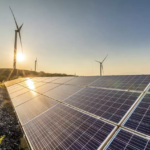India, along with France, hosted the first International Solar summit on March 11 in New Delhi, a major milestone in India’s rise as a leader in the renewable energy sector. Prime Minister Narendra Modi’s idea of forming an International Solar Alliance (ISA) was well received during the COP21 Climate Conference in Paris in November 2015, eventually leading to the creation of a Gurugram-based United Nations treaty body, registered under article 102 of the UN charter, on December 6, 2017.
With 60 countries signing the ISA agreement and 26 ratifying it so far, the idea has gained currency especially among developing countries in the Global South that are yet to achieve the desired economic development, for which energy security is an inevitable driver. The ambitious plan put forth by ISA for 2030 is to galvanize investments worth $1 trillion for harnessing solar energy.
Many countries in tropical regions, with ample sunshine, are developing countries in Asia, Africa, Latin America, and the Pacific. Helping these countries utilize solar energy, which they have in abundance, is the primary idea behind the alliance. India’s initiative to equip many developing countries in the tropics to generate solar energy would help them walk on the path of economic development as economic growth is inextricably linked to access, availability, and affordability of energy.
For India, this is a bold step in the direction of embracing renewable energy and taking a leadership role in pushing for a solar energy revolution. This further emphasizes India’s steady commitment to the Paris Agreement and its strong will to push for solar energy generation in countries that have huge potential.
Moving toward renewable energy sources has become an important aspect for India to be understood as a responsible emerging power. India has to sustain its economic growth and industrial production as well as tackle climate change and environment degradation. As an emerging power, India’s desire for energy security lies in increasing the share of renewable energy in its energy mix. Solar energy factors in as a clean and affordable form of renewable energy that would help India cut down its carbon emissions as well as reduce its dependency, at least to some extent, on the import of crude oil from West Asia, Africa, and Latin America.
Challenges in adopting solar energy exist in most of the developing world, including issues related to infrastructure development and technological know-how, attracting foreign investment, procuring raw materials for solar panels, and a lack of access to existing storage technologies. While these concerns remain, India is taking the initiative to make solar energy an important part of the energy mix of developing countries and overcome some of the challenges, thereby also boosting India’s long-standing commitment to South-South cooperation.
India has been involved in capacity-building and offering technical assistance to developing countries in the Global South under the Indian Technical and Economic Cooperation (ITEC), including in renewable energy. Training programs like the “Solar Grandmas” train women from different developing countries, particularly Africa, to prepare lanterns and solar panels at Barefoot College in Rajasthan, helping them utilize the potential for harnessing solar energy. These technical assistance programs have garnered immense goodwill for India.
Most of India gets sunshine for more than 300 days a year; this puts the country in an advantageous position to push for greater generation of and access to solar energy. Advances in technological innovation have cut the cost of clean energy technologies considerably in the past decade. In 2017, solar power tariffs dropped as low as 2.44 Indian rupees (about 4 U.S. cents) per unit, which marks the beginning of exponential growth in India’s renewable energy sector.
Currently, India has 40 million households without electricity, and the government of India’s aim is to provide “24×7 Power for All” by 2022, and increase the share of non-fossil based capacity in its electricity mix to be above 40 percent by 2030. India has also set an ambitious target of generating 175 gigawatts (GW) of renewable energy by 2022, out of which 100 GW will be solar. India’s efforts toward adopting solar energy are recognized, but more support from the international community is required for reducing the cost of equipment, building infrastructure, bringing in low-cost financing, and reducing tariffs.
For the global community, supporting such an alliance also means supporting developing countries to achieve the Sustainable Development Goals (SDGs). SDG 7, to “ensure access to affordable, reliable, sustainable and modern energy for all,” makes energy an important aspect of the goals and as a clean source of energy, solar becomes even more crucial in this debate.
While the countries that signed and ratified the ISA framework agreement largely belong to the Global South, there is room for many developed countries, like the United States and the United Kingdom, to join the group. Since the United States pulled out of the Paris Agreement, however, bringing Washington into the ISA looks like a challenging prospect. Besides, the United States seems to be preparing for trade wars with China on the import of cheap solar panels, which, according to U.S. President Donald Trump, is impacting U.S. manufacturers.
Support from major solar-powered countries like Germany is also important for the ISA member states in their own clean energy transitions. Through the ISA, member states can share best practices and support each other in their effort to build a green and sustainable future.
China is taking giant strides in the world of solar energy. It dominates the global solar panel manufacturing industry and enjoys a near monopoly in the rare earth elements market. Bringing China into the alliance would be a significant development, but requires astute diplomatic efforts from the ISA leadership.
While fossil fuels will dominate the energy market for a few years yet, the future of energy is solar, which could be the game-changer provided advance storage technologies are developed. ISA is an alliance of countries that are envisaging a common green future. Learning from varied experiences and sharing best practices would be important for ISA to be a truly leading organization in developing solar energy.







Leave a Reply